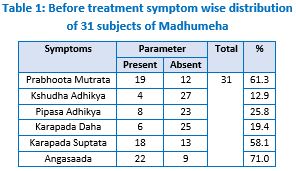An open label, single arm prospective clinical study on the effectiveness of Pugaarimeda Kashaya in Madhumeha (Diabetes Mellitus Type 2)
DOI:
https://doi.org/10.21760/jaims.7.8.1Keywords:
Madhumeha; Diabetes Mellitus; Pugaarimeda KashayaAbstract
Background: Diabetes mellitus (DM) is one of the most common non-communicable diseases globally. It is characterized by multiple metabolic disorders that results in hyperglycemia. Diabetes mellitus type-2 (DM2) is the most common type accounting almost 90% of cases of DM. Madhumeha on the basis of similar etiology, signs and symptoms can be co-related with Diabetes mellitus type-2. It is also described by the term Kshoudrameha or Ojomeha. Pugaarimeda Kashaya with Madhu as Anupana is mentioned in Brihat Nighantu Ratnakara in the management of Madhumeha. Objective: To clinically evaluate the effectiveness of Pugaarimeda Kashaya in Madhumeha (Diabetes mellitus type-2). Materials and Methods: Among 31 registered subjects, 28 of them completed the course of treatment. They were administered with Pugaarimeda Kashaya orally 100ml per day (50ml twice daily before food) with Anupana of Madhu 5ml for a period of 30 days. Blood and urine glucose test was done on 1st, 31st day of study initiation. For Statistical analysis subjective parameters were assessed by Cochran’s Q test followed by McNemar test and objective parameters were assessed by Paired sample T Test. Results: There was statistically significant improvement observed in the signs and symptoms of Madhumeha with blood and urine glucose levels. (p<0.05) Conclusion: Pugaarimeda Kashaya was found effective in the management of Madhumeha.
Downloads
References
International Diabetes Federation. IDF Diabetes Atlas, 10th ed. Brussels, Belgium: 2021. https://www.diabetesatlas.org
Kleinfield,N.R. Modern ways open India’s doors to Diabetes. New York Times: Retrieved 8th june2012; epidemiology of diabetes. Wikipedia : 2020. https://en.m.wikipedia.org/wiki/Epidemiologyofdiabetes
WHO 2016. Global report on diabetes, World Health Organization, 20 avenue Appia,1211 Geneva 27, Switzerland, 86p.
Ramachandran A, Snehalatha C. Epidemiology and Basic Considerations of Diabetes. In: Sharma KS, Agarwal AK, Gupta P, Kamath AS, Nadkar YM, Pangtey SG et.al. API Textbook of Medicine. 10th edition. New Delhi: Jaypee Brothers Medical Publishers (p) Ltd; 2015..Vol 2.p.459.
Agnivesha, Charaka, Cakrapanidatta. Nidanasthana, Chapter 4, Verse 47. In: Sharma RK, Dash B, (edi.). Charaka Samhita. Reprint 2011. Varanasi: Chaukamba Sanskrit Series Office; 2011.vol 1. p.327.
Vagbhata, Nidanasthana, chapter 6, verse 18. In : Murthy Srikantha K R (edi.) . English translation of Astangahrdayam of Vagbhata. Reprint 2012 edition. Varanasi: Chowkhamba Krishnadas Academy; 2012. Vol 2. P.95
Srikantha Murthy KR, English translation on Susruta Samhita, Nidanasthana; Chapter 6, Verse 12; Varanasi: Chaukhambha Orientalia,2012:p.506
Agnivesa, Charaka, Cakrapanidatta. Sutrasthana, Chapter 17, Verse 78-82. In: Sharma RK, Dash B, (edi.). English translation of Charaka Samhita. Varanasi: Chaukamba Sanskrit Series Office; reprint 2005.vol 3. p. 327
Dattaram Srikrishnalal Mathura, Hindi teekakarasahita of on Brihatnighanturatnakara, Volume 5; Prameharogakarmavipaka: Mumbai: Khemraja Srikrishnadas Prakashana; p.805
Narahari, Indradev Tripathi. Amradivarga, verse233-245. In: Vishwanah Dvivedi (edi.) Dravyaguna Prakashika Hindi commentary of Rajanighantu. Varanasi: Krishnadas Academy: Edition 1682.p.136
Narahari, Indradev Tripathi. Shalmalyadi Varga, verse 28-31. In: Vishwanah Dvivedi (edi.) Dravyaguna Prakashika Hindi commentary of Rajanighantu. Varanasi: Krishnadas Academy: Edition 1682.p.237
S.Keshava Bhat, D. Ashwin and S. Mythri, Antidiabetic Potential of Areca nut, Areca catechu L. and certain Arecanut formulations available for treating Diabetes. Indian Journal of Arecanut, Spices & Medicinal plantsVol-19(1)
L.Kavitha, B.Kumarvavel, G.Sriram Prasath, S.Subramaniah. Beneficial role of Areca catechu nut extract in Alloxan-induced Diabetic rats. Research J.Pharmacognosy and Phytochemistry 2013;5(2):100-108
Ahmed et al., A Trimeric Proanthocyanidin from the Bark of Acacia leucophloe Willd. ACG publications, EISSN:1307-6167, 2014: 294-298.
American Diabetes Association. 2.Classification and diagnosis of diabetes: Standards of Medical Care in Diabetes—2018. Diabetes Care 2018; 41(Suppl. 1): S13–S27
Alvin C Power, Endocrinology and Metabolism, In: Kapser, Fauci, Hausen, Longo, Janseon, Loscalzo (edi.). Harrison’s principles of internal medicine. 19thedition. New York: McGraw Hill Education; 2015.p.2400
Suresh K Pandey, S. Vidushi. World Diabetes Day 2018: Battling the Emerging Epidemic of Diabetic Retinopathy. Indian J.Ophthalmol. 2018 Nov; 66(11)1652-1653.















